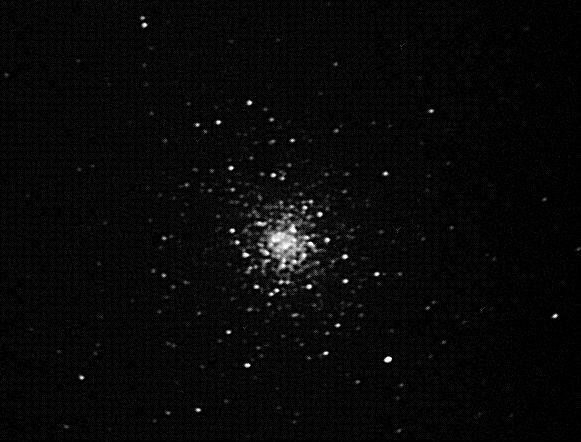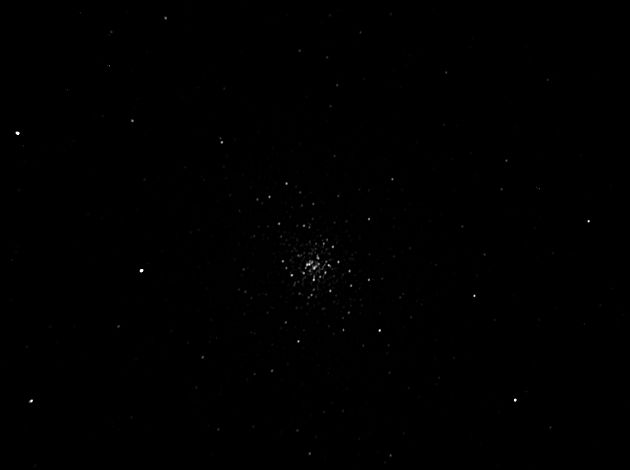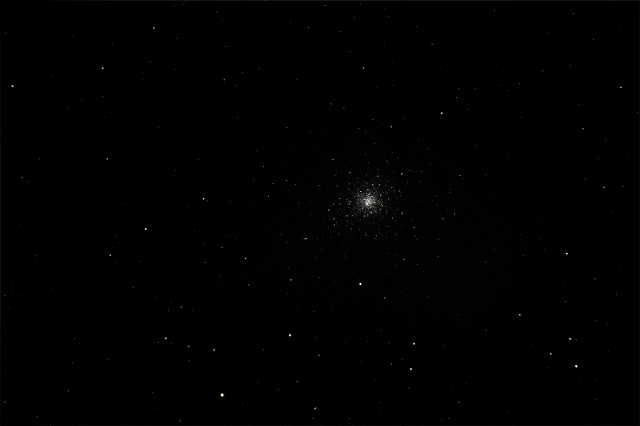

M92 was discovered by Johann Elert Bode on 27th December 1777 and rediscovered by Charles Messier on 18th March 1781 and entered as number 92 in his catalogue. William Herschel was the first to resolve it into stars in 1783. The cluster is about 27,000 light years away in the constellation Hercules. It subtends an angle of about 12 arc-minutes (the exact size depends on where you think the edges are) so that its real extent is about 100 light years. It is approaching us at 112 Km/sec. About 12,000 years ago it was within 1° of the north celestial pole, and will be again in 12,000 years time as the Earth's axis precesses in space.
 |
M92 captured with my LX200 fitted with a 0.33 focal reducer. This cluster has a very bright central region and, in order to resolve this together with the fainter stars I had to combine three exposures. Each avi was aligned and stacked in K3CCDTools, the resulting pictures were trimmed to size and then loaded into RegiStax for manual alignment. The aligned frames were exported as an avi file which was loaded into K3CCDTools for alignment and stacking using the Planetary Wizard and further application of the unsharp mask. Finally the background was adjusted to black in PhotoImpact. Date and Time: 1st May 2007 22:48 to 23:02 UT Camera: Atik 1-HS Telescope: LX200 with 0.33 focal reducer Capture: K3CCDTools. Low gamma, exposures 5, 10, 20 sec, 100% gain Processing: K3CCDTools. Best 15-20 frames stacked, histogram adjusted, unsharp mask 3 pixels, factor 150, gamma 0.8 |
||
 |
This picture was captured with the same optics as the picture above but with my MX716 camera with its bigger pixels. Normally I use this camera in fast mode but for this picture I tried out the progressive mode which is said to produce a better vertical resolution. The picture taken using fast mode is in the mouseover. The two images were produced with exactly the same processing. (I don't know where the two extra stars came from in the progressive-mode picture. I think they are hot pixels which, for some reason, did not subtract out with the dark frame.) Date and Time: 30th September 2011 22:48 to 23:02 UT Camera: Starlight Xpress Mx716 Telescope: LX200 with 0.33 focal reducer Capture: Star_mx7. Exposure 15 seconds, 10 frames Processing: Star_mx7. Subtraction of dark frame RegiStax6. 10 frames stacked, Gaussian wavelets Scheme 1. |
||
 |
This wider-angle picture was captured using a DSLR and an 8-inch Ritchey-Chrétien telescope. The image here is reduced to fit the page but to see the largest image available, click on the image. Close the window that opens to return here. Date and Time: 25th March 2020 22:57 to 23:47 UT Camera: Canon 1100D Telescope: 8-inch Ritchey-Chrétien Capture: Canon EOS. Exposure 30, 60, 120 seconds, 20, 10, 10 frames Processing: RegiStax6. For each exposure, all frames stacked, wavelets 1-2=10, gamma 0.6. Some sharpening in Focus Magic |
||
Home Back to DSOs